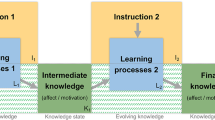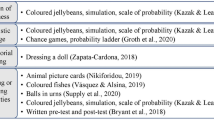Abstract
In mathematics education research, proofs are often conceptualized as sequences of mathematical assertions. We argue that this ignores proofs that contain instructions to perform mathematical actions, often in the form of imperatives, which are common both in mathematical practice and in undergraduate mathematics textbooks. We consider in detail a specific type of proof which we call a recipe proof, which is comprised of sequence of instructions that direct the reader to produce mathematical objects with desirable properties. We present a model of what it means to understand a recipe proof and use this model in conjunction with process-object theories from mathematics education research, to explain why recipe proofs are inherently difficult for students to understand.
Similar content being viewed by others
Data availability
This is a theoretical paper that is not based on data, so there is no data to share.
Notes
Throughout this paper, we treat “mathematical assertion” and “mathematical statement” as synonymous.
Not all textbooks present the Bolzano Weierstrass Theorem in the same way, and some may use fewer or different instructions. We are treating this as an illustrative example, but not necessarily a representative one. Whether and when mathematicians should use instruction-based proofs is an interesting didactical question. The effects it has on student cognition is a worthwhile research question.
The B-W Theorem does not depend on the Axiom of Choice, and the proof could have been amended to avoid its use. For instance, if the instructions had been to choose the left half-interval if there were an infinite number of terms of the sequence in it and the right interval otherwise, and if nk+1 had been chosen to be the least index greater than nk such that xn(k+1) was in that interval, no choice function would be necessary.
In the philosophical literature, Azzouni (2004) has used the recipe analogy in a different way: A proof is a recipe to produce a formal derivation that a formally stated version of the theorem is true. Elsewhere, each author has argued against that position (Tanswell, 2015; Weber, 2021), and we are not using that analogy here.
To avoid misinterpretation, “proving activities” in this case refers to deductively justifying within a proof, not broader activities associated with proof like conjecturing or generalizing.
Consider the sequence defined by an = 1 if n = 1 or if there is an odd perfect number less than n, and an = 0 otherwise. We cannot determine the tail of this sequence because we do not know if an odd perfect number exists.
A similar suggestion is made by Hamami and Morris (2020).
References
Anderson, I. (2002). A first course in discrete mathematics. Springer.
Azzouni, J. (2004). The derivation-indicator view of mathematical practice. Philosophia Mathematica, 12(2), 81–106.
Balacheff, N. (2008). The role of the researcher’s epistemology in mathematics education: An essay on the case of proof. ZDM-Mathematics Education, 40(3), 501–512.
Conradie, J., & Frith, J. (2000). Comprehension tests in mathematics. Educational Studies in Mathematics, 42, 225–235.
Cottrill, J., Dubinsky, E., Nichols, D., Schwingendorf, K., Thomas, K., & Vidakovic, D. (1996). Understanding the limit concept: Beginning with a coordinated process schema. Journal of Mathematical Behavior, 15(2), 167–192.
Cowen, C. (1991). Teaching and testing mathematics reading. The American Mathematical Monthly, 98(1), 50–53.
Davis, R. (1983). Complex mathematical cognition. In H. Ginsburg (Ed.), The development of mathematical thinking (pp. 254–290). Academic Press.
Davis, R. (1984). Learning mathematics: The cognitive science approach to mathematics education. Ablex.
Dawkins, P. C., & Weber, K. (2017). Values and norms of proof for mathematicians and students. Educational Studies in Mathematics, 95(2), 123–142.
Dawkins, P. & Zazkis, D. (in press). Using moment-by-moment reading protocols to understand students’ processes of reading mathematical proof. To appear in Journal for Research in Mathematics Education.
Dubinsky, E., Dautermann, J., Leron, U., et al. (1994). On learning fundamental concepts of group theory. Educational Studies in Mathematics, 27(3), 267–305.
Duval, R. (1991). Structure du raisonnement déductif et apprentissage de la démonstration. Educational Studies in Mathematics, 22(3), 233–263.
Duval, R. (2007). Cognitive functioning and the understanding of mathematical processes of proof. In P. Boero (Ed.), Theorems in school: From historic, epistemology, and cognition to classroom practice (pp. 163–181). Rotterdam: The Netherlands: Sense.
Epp, S. (2003). The role of logic in teaching proof. The American Mathematical Monthly, 110(10), 886–899.
Ernest, P. (1998). Social constructivism as a philosophy of mathematics. State University of New York Press.
Fukawa-Connelly, T. (2014). Using Toulmin analysis to analyse an instructor’s proof presentation in abstract algebra. International Journal of Mathematical Education in Science and Technology, 45(1), 75–88.
Hamami, Y., & Morris, R. (2020). Plans and planning in mathematical proofs. The Review of Symbolic Logic, 1–36.
Hanna, G., & Barbeau, E. (2008). Proofs as bearers of mathematical knowledge. ZDM-Mathematics Education, 40, 345–353.
Harel, G., & Sowder, L. (1998). Students’ proof schemes: Results from exploratory studies. In A. H. Schoenfeld, J. Kaput, & E. Dubinsky (Eds.), Research in collegiate mathematics education III (pp. 234–283). American Mathematical Society.
Healy, L., & Hoyles, C. (2000). Proof conceptions in algebra. Journal for Research in Mathematics Education, 31, 396–428.
Herbst, P. (2002). Establishing a custom of proving in American school geometry: Evolution of the two-column proof in the early twentieth century. Educational Studies in Mathematics, 49, 283–312.
Hunter, J. (2014). An introduction to real analysis. UC Davis: California.
Inglis, M., & Alcock, L. (2012). Expert and novice approaches to reading mathematical proofs. Journal for Research in Mathematics Education, 43, 358–390.
Ko, Y., & Knuth, E. (2009). Undergraduate mathematics majors’ writing performance producing proofs and counterexamples about continuous functions. The Journal of Mathematical Behavior, 28(1), 68–77.
Ko, Y., & Knuth, E. (2013). Validating proofs and counterexamples across content domains: Practices of importance for mathematics majors. The Journal of Mathematical Behavior, 32(1), 20–35.
Krantz, S. (1997). A primer of mathematical writing. American Mathematical Society.
Kunen, K. (1980). Set theory: An introduction to independence proofs. North-Holland.
Larson, R., Boswell, L., Kanold, T., et al (2003). Geometry. McDougal Littell.
Leron, U. (1983). Structuring mathematical proofs. The American Mathematical Monthly, 90(3), 174–185.
Leron, U., & Dubinsky, E. (1995). An abstract algebra story. The American Mathematical Monthly, 102(3), 227–242.
Lin, P., & Tsai, W. (2016). Enhancing students mathematical conjecturing and justification in third-grade classrooms. Journal of Mathematics Education, 9, 1–15.
Linnebo, Ø., & Shapiro, S. (2019). Actual and potential infinity. Noûs, 53, 160–191.
Mariotti, M. (2000). Introduction to proof: The mediation of dynamic software environment. Educational Studies in Mathematics, 44, 25–53.
Mejía-Ramos, J. P., Fuller, E., Weber, K., et al. (2012). An assessment model for proof comprehension in undergraduate mathematics. Educational Studies in Mathematics, 79(1), 3–18.
Mejiía-Ramos, J. P., & Weber, K. (2019). Mathematics majors’ diagram usage when writing proofs in calculus. Journal for Research in Mathematics Education, 50(5), 478–488.
Pedemonte, B. (2007). How can the relationship between argumentation and proof be analysed? Educational Studies in Mathematics, 66, 23–41.
Pimm, D. (1987). Speaking mathematically: Communication in mathematics classrooms. Routledge & Kegan Paul.
Rav, Y. (1999). Why do we prove theorems? Philosophia Mathematica, 7, 5–41.
Reid, D. A., & Knipping, C. (2010). Proof in mathematics education: Research, learning, and teaching. Rotterdam, The Netherlands: Sense.
Rotman, B. (1988). Towards a semiotics of mathematics. Semiotica, 72, 1–35.
Rotman, B. (1993) Ad Infinitum... The Ghost in Turing’s Machine, Stanford: Stanford University Press.
Selden, A., & Selden, J. (2003). Validations of proofs written as texts: Can undergraduates tell whether an argument proves a theorem? Journal for Research in Mathematics Education, 36(1), 4–36.
Sfard, A. (1991). On the dual nature of mathematical conceptions: Reflections on processes and objects as different sides of the same coin. Educational Studies in Mathematics, 22(1), 1–36.
Simon, M. (1996). Beyond inductive and deductive reasoning: The search for a sense of knowing. Educational Studies in Mathematics, 30(2), 197–210.
Stylianides, A. (2007). Proof and proving in school mathematics. Journal for Research in Mathematics Education, 38, 289–321.
Stylianides, G., Stylianides, A. & Weber, K. (2017). Research on the teaching and learning of proof: Taking stock and moving forward. In J. Cai (ed.) Compendium for Research in Mathematics Education (pp. 237–266). NCTM: Reston.
Tanswell, F. (2015). A problem with the dependence of informal proofs on formal proofs. Philosophia Mathematica, 23, 295–310.
Tanswell, F. (in press) Go forth and multiply: On actions, instructions and imperatives in mathematical proofs, in J. Brown & O. Bueno (eds.) Essays on the Philosophy of Jody Azzouni, Cham: Springer.
Tanswell, F. & Inglis, M. (in press). The language of proofs: A philosophical corpus linguistic study of instructions and imperatives in mathematical proofs. In B. Srirariman (Ed.) Handbook of the history and philosophy of mathematical practice. Springer.
Tanswell, F., & Rittberg, C. (2020). Epistemic injustice in mathematics education. ZDM-Mathematics Education, 52, 1199–1210.
Toulmin, S. (2003). The uses of argument. Cambridge University Press.
Weber, K. (2001). Student difficulty in constructing proofs: The need for strategic knowledge. Educational Studies in Mathematics, 48(1), 101–119.
Weber, K. (2021). The role of syntactic representations in set theory. Synthese, 198, 6393–6412.
Weber, K., & Alcock, L. (2005). Using warranted implications to understand and validate proofs. For the Learning of Mathematics, 25(1), 34–38.
Weber, K., Inglis, M., & Mejía-Ramos, J. P. (2014). How mathematicians obtain conviction: Implications for mathematics instruction and research on epistemic cognition. Educational Psychologist, 49(1), 36–58.
Weber, K., & Mejía-Ramos, J. P. (2011). Why and how mathematicians read proofs: An exploratory study. Educational Studies in Mathematics, 76(3), 329–344.
Yang, K., & Lin, F. (2008). A model of reading comprehension of geometry proof. Educational Studies in Mathematics, 67(1), 59–76.
Acknowledgements
We would like to thank Paul Dawkins, Anderson Norton, and the anonymous reviewers for useful feedback on an earlier version of this manuscript. The research of the second author is funded by the Research Foundation – Flanders (FWO) - Project G083620N - The Epistemology of Data Science: Mathematics and the Critical Research Agenda on Data Practices.
Author information
Authors and Affiliations
Corresponding author
Ethics declarations
Conflict of interest
The authors declare no competing interests.
Additional information
Publisher's note
Springer Nature remains neutral with regard to jurisdictional claims in published maps and institutional affiliations.
Rights and permissions
About this article
Cite this article
Weber, K., Tanswell, F.S. Instructions and recipes in mathematical proofs. Educ Stud Math 111, 73–87 (2022). https://doi.org/10.1007/s10649-022-10156-2
Accepted:
Published:
Issue Date:
DOI: https://doi.org/10.1007/s10649-022-10156-2




